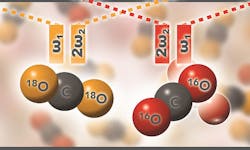Spectroscopy research from PNNL identifies Raman shift in supercritical carbon dioxide
Richland, WA--Researchers from the U.S. Department of Energy's Pacific Northwest National Laboratory (PNNL) studying geologic carbon storage using spectroscopy have solved a mystery concerning the nature of supercritical carbon dioxide, which exhibits a vibrational puzzle known as Fermi resonance. PNNL chemist and author Charles Windisch, Jr. said, "We figured out how the different carbon dioxide molecules are vibrating at some of the Fermi resonance frequencies. And, of course, we can calibrate our data with more accuracy now." The research is described in the February 28 issue of the journal in Physical Chemistry Chemical Physics."Even to this day, people mark Raman spectra incorrectly," said PNNL computational chemist Vassiliki-Alexandra Glezakou. "It helps to know what we are looking at, if we are going to use certain bands as guidelines to understand molecular interactions."
The PNNL researchers did not set out to study again a phenomenon that dates back to the 1930s. Instead, they wanted to investigate what happens when carbon dioxide is stored underground as part of a national research effort to reduce carbon emissions from power generation. To do so, researchers plan to inject carbon dioxide in an unusual form of the gas that behaves like a liquid due to being under high pressure, called supercritical. To follow supercritical carbon dioxide in chemical reactions, researchers often use Raman spectroscopy.
The number and position of peaks in a Raman spectrum can be predicted by quantum mechanics, but Fermi resonances result in unanticipated peaks due to a combination of two different vibrations, such as stretching and bending. First recognized in carbon dioxide and explained by Enrico Fermi in 1931, scientists agree that the Fermi peaks are the result of the mixing of the two vibrational modes, but they often label one of them as 'stretch' and the other as 'bend'. This labeling became a problem when PNNL researchers observed a 'flip' in the Raman spectrum of supercritical carbon dioxide.
Normally, carbon dioxide contains carbon plus the isotope oxygen-16, the most common form of oxygen. By using a heavier isotope of oxygen with its own fingerprint, oxygen-18, PNNL researchers can track the fate of carbon dioxide when it reacts with minerals, particularly when there are other sources of oxygen present such as water. In the Raman spectra of the lighter supercritical carbon dioxide, the pair of Fermi peaks included a weaker one at a lower frequency and a stronger one at higher frequency. When they replaced all of the oxygens with the heavier isotope, however, the peaks seemed to flip, with the stronger one appearing at a lower frequency instead.
The researchers needed to unambiguously identify the peaks and to figure out how much bending and stretching modes contributed to each one. To do so, the team decided to simulate the carbon dioxide molecules with different oxygen isotopes on a computer and see if they could recreate the Raman spectra they saw in their experiments.
Using computing resources at EMSL, DOE's Environmental Molecular Sciences Laboratory at PNNL, Glezakou simulated carbon dioxide in supercritical conditions similar to those in the experiment. The molecules were "made" with either oxygen-16 or oxygen-18. They analyzed the motion of the molecules to produce computational spectra that echoed the real spectra. In this way, the team was able to determine the percent of bending and stretching modes expected in each peak. The results showed that with oxygen-16, the stronger peak at the higher frequency is due mostly to the stretching mode, while the weaker peak at the lower frequency is due mostly to the bending mode.
Oxygen-18, however, told a different story. The results with heavy carbon dioxide showed unequivocally that the light- and heavy-oxygen peaks were not exactly mirror images of each other. Carbon dioxide is mostly a linear molecule, so the bending motion is much less affected than the stretch when the oxygen-16 is replaced by its heavier isotope. As a result, the composition of the peaks does not remain the same. "The heavier oxygen doesn't just shift the peaks. It changes their identity," said Glezakou. "And the bigger effects are on the stretching, because the peak with the most stretching has the biggest frequency shift."
Windisch added that the experimental results matched the computational ones nicely, in spite of the difficulty. "Our colleague Paul Martin here at PNNL had to build equipment so we could do these experiments at the pressures we needed. Not easy," he said.
Having nailed down the vibrational pedigree of these carbon dioxide molecules, they plan to use these results to understand better other reactions between carbon dioxide and a variety of minerals.
SOURCE: PNNL; www.pnnl.gov/news/release.aspx?id=915

Gail Overton | Senior Editor (2004-2020)
Gail has more than 30 years of engineering, marketing, product management, and editorial experience in the photonics and optical communications industry. Before joining the staff at Laser Focus World in 2004, she held many product management and product marketing roles in the fiber-optics industry, most notably at Hughes (El Segundo, CA), GTE Labs (Waltham, MA), Corning (Corning, NY), Photon Kinetics (Beaverton, OR), and Newport Corporation (Irvine, CA). During her marketing career, Gail published articles in WDM Solutions and Sensors magazine and traveled internationally to conduct product and sales training. Gail received her BS degree in physics, with an emphasis in optics, from San Diego State University in San Diego, CA in May 1986.
